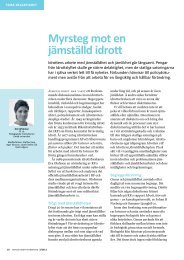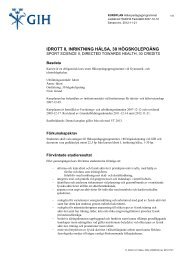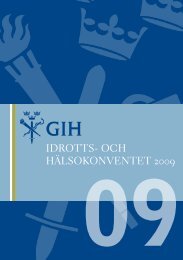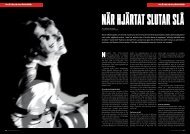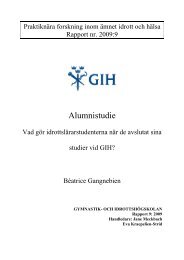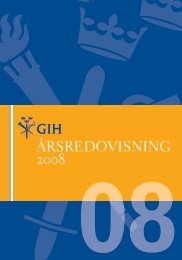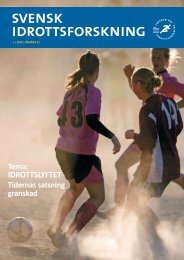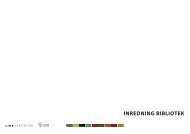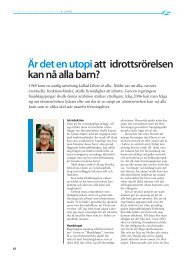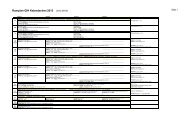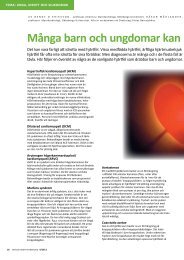Programme and abstracts - GIH
Programme and abstracts - GIH
Programme and abstracts - GIH
Create successful ePaper yourself
Turn your PDF publications into a flip-book with our unique Google optimized e-Paper software.
Map over <strong>GIH</strong> Campus <strong>and</strong> surroundings2
Accomodation at STF af ChapmanAccommodation will be at the STF Hostel af Chapman & Skeppsholmen, beautifullylocated by the water at Skeppsholmen in central Stockholm. You will beaccommodated in shared rooms for 2-6 persons, breakfast, towel <strong>and</strong> linen. Toilets<strong>and</strong> shovers are located in the hall. ( http://www.svenskaturistforeningen.se/ )Map with directions from STF af Chapman (A) via Haglöfs Br<strong>and</strong>store (B) to <strong>GIH</strong> (C)Haglöfs br<strong>and</strong>storeIn the bag you have received when register for the seminar you will find a discountvoucher valid at Haglöfs Br<strong>and</strong>store. Haglöfs Br<strong>and</strong>store is located at the way fromSTF af Chapman to <strong>GIH</strong> (see map above). Haglöfs has also contributed to theseminar delegates with a book of photographer Claes Grundsten. We hope you willhave the time to visit Haglöfs sometime during the seminar.3
General information--------Name badgePlease wear your name badge while attending the sessions <strong>and</strong> events, as itindicates that you are registered <strong>and</strong> permitted to attend.Oral paper presentationsEach presenter of papers will have 20-25 minutes for the presentation<strong>and</strong> 5-10 minutes for questions/discussions. Make sure you download yourpresentation to the computer in your lecture room before your session begins.There is a roomkeeper in each lecture room who will assist you with practicalmatters. Each session also has a chair person who is responsible for timekeeping <strong>and</strong> introduction of each presenter. Please introduce yourself to thechair before your session begins. You are free to listen to any presentationyou would like. We hope that there will be an audience at all the sessions.Poster sessionThe poster session is Thursday June 6th at 14.00–15.00 in a hall next to therestaurant. An award for best poster will be given at the dinner on Saturday.For those who are presenting posters, please bring them to the receptionwhen you arrive.Practical workshopsThere are a few scheduled sessions with practical workshops during theseminar. The time allocated to these workshops is 90 min. Most of theworkshops will take place outside, although some of them might also have partof the workshop inside. If some workshops will take place in the forest nearby<strong>GIH</strong>, the 90 min includes walking there <strong>and</strong> back. If you are holding a practicalworkshops, please contact Erik when you arrive to check details with time,material etc. You are free to take part in any workshop you would like. Wehope that there will be an audience at all the workshops.Sauna <strong>and</strong> physical activitiesFor those who are interested, there will also be opportunities for indoor training<strong>and</strong> sauna at <strong>GIH</strong>.InternetAll seminar participants have free access to the Internetthrough wireless network at Campus <strong>GIH</strong>. Choose network: <strong>GIH</strong> Gast.Username:eoe. Password: eoe.ElectricityVoltage: 220-240 V. Primary Socket Type: Europlug.Meals <strong>and</strong> refreshmentsAll meals will be served at Ling-baren, the restaurant at <strong>GIH</strong>. There is a bar atthe restaurant with different beverages for purchase.4
------Credit cardsAll major credit cards are accepted at the restaurant at <strong>GIH</strong>, <strong>and</strong> at mostrestaurants, hotels <strong>and</strong> stores in Sweden.Medical careYou can call the Stockholm Health Care Guide Hotline (Vårdguiden) free ofcharge (minus the small charge for a local phone call) for medical advice 24hours a day by calling +46(0)8 320 100. Press option #1 for generalinformation about health care in Stockholm <strong>and</strong> #3 for personal advice by anurse. For more information, visit www.vardguiden.se.Emergency numberGeneral emergency number (police, ambulance, firefighters etc): 112. If yourun into other problems during the seminar, you are welcome to call ErikBackman at +46 (0)70 459 97 00.Transport within StockholmThere is a well developed public transport system in Stockholm with buses<strong>and</strong> subway. If you need to buy tickets, there are ticket-machines available atthe subway-stations. You can also buy tickets from small stores such asPressbyrån <strong>and</strong> Seven-Eleven.Shower <strong>and</strong> wardrobe at <strong>GIH</strong>During the seminar, you will have access to showers <strong>and</strong> sauna at <strong>GIH</strong>. Dueto the distance between STF af Chapman <strong>and</strong> <strong>GIH</strong> (approx. 30-40 min walk)we recommend you to bring all the things you need during the day to <strong>GIH</strong>.There will be a guarded wardrobe by the reception at <strong>GIH</strong> where you storeyour things during the day.Outdoor activitiesDuring the seminar, there will be several formal <strong>and</strong> informal opportunities foroutdoor activities. Therefore we would like to encourage you to bring suitableoutdoor clothes, both for sun <strong>and</strong> rain.On Friday at 14.00-19.30 there will be arranged outdoor activities with leadersfrom <strong>GIH</strong>. Below you can read about the different activities to choose from:Kayak, 30 places.Experience kayaking in Brunnsviken under supervision from experiencedoutdoor educators. You will have the chance to develop your paddlingskills as well as your knowledge of historical places in Stockholm urbannature. Hopefully you will also get a joyful kayaking experience! No priorexperience needed. Our experienced leaders will take care of you. Bringsome extra clothes for change, you might get wet.Cycling, 30 places.Join in for a cycling tour around Brunnsviken <strong>and</strong> learn more abouthistorical places in Stockholm urban nature under the guidance fromProfessor Peter Schantz. You can choose your own pace, our leaders5
will keep the group together. Helmets will be provided. You might need asmall backpack for something to drink <strong>and</strong> a snack.Parkour, 30 places.Take the chance to learn more about parkour under guidance fromexperienced parkour teachers Tage Sterner <strong>and</strong> Rudi Zangerl. In thiscombined practice- <strong>and</strong> theory-course you will learn about the philosophyin parkour <strong>and</strong> basic aspects of safety. You will also visit a parkourl<strong>and</strong>scape,designed by Tage Sterner <strong>and</strong> Rudi Zangerl, <strong>and</strong> practiceyour skills. Bring comfortable clothing <strong>and</strong> shoes for jogging or indoorsports, you might get a bit warm. No prior experience needed, nodem<strong>and</strong>s on physical status.Please register for the outdoor activities above at the registration desk duringThursday from 13.00-15.00.Publication of papersDuring the seminar, you will be encouraged to submit a written paper of yourpresentation. The paper must be in English with a length of 5-10 pages. Thesubmissions will result in an E-book. If we find a financial solution, perhaps there willalso be a publication in paper. Deadline for submissions will be August 30Participantsth .<strong>GIH</strong> EOE 2013 - Last nameLast name First name Company Country E-mailá Kosini Charlotte S. SFS Reykjavik Icel<strong>and</strong> charlotte.sigrid.a.kosini@reykjavik.isActon Jane nature workshops United Kingdom jane@natureworkshops.co.ukActon Tara nature workshops United Kingdom baggyp13@hotmail.comAdams Dave The Outward Bound Trust United Kingdom dave.adams@outwardbound.org.ukAhnesjö Jonas Linnaeus university Sweden jonas.ahnesjo@lnu.seAldener Marie Sweden marie.aldener@edu.vaxholm.seAlsegård Helena National Centre for Outdoor Education (NCU) Sweden helena.alsegard@liu.seArnegård Johan <strong>GIH</strong> Sweden johan.arnegard@gih.seArngrimsson Gudmundur Hrafn Cursus Icel<strong>and</strong> Icel<strong>and</strong> gudmundur@cursusicel<strong>and</strong>.comArnthorsson Agnar SFS Reykjavik Icel<strong>and</strong> agnar.arnthorsson@reykjavik.isAsano Yoshiko Örebrö University Sweden asayoshi55@hotmail.comAsgeirsson Oskar Örn SFS Reykjavik Icel<strong>and</strong> oskarornasgeirsson@gmail.comBackman Erik <strong>GIH</strong>/Friluftsfrämj<strong>and</strong>et Sweden erik.backman@gih.seBartle Patrick Nyströmska skola Sweden patrick.bartle@soderkoping.seBecker Peter bsj Marburg Germany drpeterbecker@googlemail.comBerentsen Vegard oslo kommune Norway vegard.berentsen@sorkedalen.gs.oslo.noBerghäll Patrik Folkhälsans Förbund rf. Finl<strong>and</strong> patrik.berghall@folkhalsan.fiBergström Birgitta Sweden birgitta.bergstrom@gih.seBjorgvinsson Egill SFS Reykjavik Icel<strong>and</strong> egillbui@gmail.comBlok Niels Overgaard HUC Denmark blok.niels@gmail.comBlöcher Sabine bsj Marburg e.V. Germany bloecher@bsj-marburg.de6
owles stephen retired Finl<strong>and</strong> bowles2u@gmail.comBrodersen Mads Vends Motorik- og Naturskole Denmark motorikognatur@gmail.comBrown David Aberdeenshire Council Ranger Service United Kingdom formartine.ranger@aberdeenshire.gov.ukChapman Lawrence The Ashley School Academy Trust United Kingdom office@ashleyschool.co.ukChristie Beth University of Edinburgh United Kingdom bethchristie@ed.ac.ukCollins Di Journeying Gently United Kingdom diane.collins80@ntlworld.comCooper Geoff Adventure <strong>and</strong> Environmental Awareness Group United Kingdom geoffcooper548@btinternet.comCzwartos Elżbieta Frajda/CEN Pol<strong>and</strong> elaczwartos@o2.plD'Rozario Vilma National Institute of Education Singapore vilma.drozario@nie.edu.sgDahl Lena Høgskolen i Sogn og Fjordane Norway lena.dahl@hisf.noDanielsson Tom Linneuniversitetet Sweden tom.danielsson@lnu.seEpstein Ann Sweden ann@kalma.seFjeld Jan-Kåre Borge skole Norway jkfj@fredrikstad.kommune.noFurmark Sven-Gunnar Luleå University of Techn ology Sweden sven.furmark@telia.comFägerstam Emilia Linköping University Sweden emilia.fagerstam@liu.seGilbert Joyce The Royal Scottish Geographical Society United Kingdom joyce.gilbert@rsgs.orgGREGORIČ RADO CŠOD Slovenia rado.gregoric@csod.siGrimekl<strong>and</strong> Geir Telemark University Collage Norway geir.grimel<strong>and</strong>@hit.noGudlaugsson Johannes SFS, Reykjavik Icel<strong>and</strong> johannes.gudlaugsson@reykjavik.isGuðbergsdóttir Anna Björk SFS Reykjavik Icel<strong>and</strong> magnus.gudmundsson@reykjavik.isGurholt Kirsti Pedersen Norges idrettshøgskole Norway kirsti.gurholt@nig.noGłowacki Przemysław Frajda/Twix Pol<strong>and</strong> info@epersonel.plHartmeyer Rikke Metropol/Århus University Denmark ridh@dpu.dkHedtke Marion BSJ Marburg/Ouerfeldein Germany querfeldein-schwerin@web.deHjarsen Thor Save the Children Denmark Denmark thj@redbarnet.dkHo Susanna Ministry of Education, Singapore Singapore Susanna_Ho@moe.gov.sgHumberstone Barbara Bucks New University United Kingdom barbara.humberstone@bucks.ac.ukJohannesson Tinni School <strong>and</strong> Leisure department of Reykjavik Icel<strong>and</strong> tinni.kari.johannesson@reykjavik.isJurewicz Katarzyna Frajda/Twix Pol<strong>and</strong> k.jurewicz@twiks.plJędrzejczyk Magdalena Frajda/CEN Pol<strong>and</strong> magda@frajda.com.plKaiser Susanne bsj Germany kaiser@bsj-marburg.deKrzywaźnia Michał Frajda/ Youth Social Center Pol<strong>and</strong> teatr.wkz@gmail.comKujala Jari Department of Social Services <strong>and</strong> Health Care Finl<strong>and</strong> jari.kujala@hel.fiKuusinen Laura Hyria koulutus Oy Finl<strong>and</strong> laura.kuusinen@hyria.fiKätting Eva Linköping University Sweden eva.katting@liu.seKöping Olsson Bengt Mälardalen University Sweden bengt.koping.olsson@mdh.seLeather Mark University of St Mark & St John United Kingdom mleather@marjon.ac.ukLesk Susanne Wirtschaftsuniversität Wien Austria susanne.lesk@wu.ac.atLindner Martin Philipps-Universität Marburg Germany martin.lindner@uni-marburg.deLundqvist-Jones Therese Nyströmska skolan Sweden tels@soderkoping.seLundvall Suzanne The Swedish School of Sport & Health Sciences Sweden suzanne.lundvall@gih.seLynch Pip Norges Idrettshøgskole Norway philippa.lynch@nih.noMannion Gregory University of Stirling United Kingdom gbgm1@stir.ac.ukMartinsen Bent Oslo og Oml<strong>and</strong> Friluftsråd Norway bmoof@online.noMikaels Jonas Umeå University Sweden jonas.mikaels@pedag.umu.se7
Mygind Erik Department of Exercise Sciences <strong>and</strong> Nutrition Denmark emygind@ifi.ku.dkNasimbwa Elizabeth STF Sweden elizabeth.nasimbwa@hotmail.comNicholls Fiona University of St Mark & St John United Kingdom fnicholls@marjon.ac.ukNilsson Kerstin <strong>GIH</strong>/Resaro skola Sweden kerstin.nilsson@gih.seOdberg Ann-Helen University of Icel<strong>and</strong> Icel<strong>and</strong> annhelen@hi.isPassy Rowena Plymouth University United Kingdom R.Passy@plymouth.ac.ukPetursdottir Kolbrun E. SFS Reykjavik Icel<strong>and</strong> kolbrunerna@internet.isReinert Johan bsj Marburg Germany integrationsprojekt@zerum-ueckermuende.deRichards Kaye Liverpool John Moores University United Kingdom k.e.richards@ljmu.ac.ukRouvinen Riikka The Finnish Youth Centre Association Finl<strong>and</strong> riikka.rouvinen@snk.fiRusjan Neva CSOD Slovenia neva.rusjan@gmail.comS<strong>and</strong>ell Klas Karlstad University Sweden Klas.S<strong>and</strong>ell@kau.seS<strong>and</strong>erud Jostein Sogn <strong>and</strong> Fjordane University College Norway jostein.s<strong>and</strong>erud@hisf.noSchantz Peter <strong>GIH</strong> Sweden peter.schantz@gih.seSchau Torstein Markaskolen Norway torstein.schau@sorkedalen.gs.oslo.noSchirp Jochem bsj Marburg Germany schirp@bsj-marburg.deSeger Jan <strong>GIH</strong> Sweden jan.seger@gih.seSeyfferth Katharina Germany k.seyfferth@gmx.netSharma Himal Human Rights <strong>and</strong> Environmental Protection, Nepal Nepal hurep.nepal1@gmail.comSmith Carly Clydeview Academy United Kingdom Carlysmith47@yahoo.comSpindler Till City Bound Wien Austria Till.Spindler@gmx.atstenberg kerstin <strong>GIH</strong> Sweden kerstin.stenberg@gih.seStewart Alistair La Trobe University Australia a.stewart@latrobe.edu.auSzczepanski Anders National Center for Outdoor Education (NCU) Sweden <strong>and</strong>ers.szczepanski@liu.seThorsteinsson Jakob F. School of Education - University of Icel<strong>and</strong> Icel<strong>and</strong> jakobf@hi.isValaker Hagen Andreas NIH Norway a.valaker@live.noVenäläinen Maija Hyria Education Finl<strong>and</strong> maija.venalainen@hyria.fiWaite Sue Plymouth University United Kingdom sjwaite@plymouth.ac.ukWestphal Ralf University Marburg Germany WestphalRalf@Hotmail.comÖsterberg Peter Österberg ledarskap & utveckling Sweden peter.osterberg@generativelearningmanagement.se8
<strong>Programme</strong>Wednesday 5 th June15.00-18.30 Arrival, accommodation <strong>and</strong> registration18.30-20.00 Pre-seminar for the EOE Network20.00-22.00 DinnerThursday 6 th June08.00-09.00 Registration09.00-10.00 Official opening- Erik Backman, The Swedish School of Sport <strong>and</strong> Health Sciences“Welcome <strong>and</strong> introduction”. The auditorium.- Sara Revell-Ford, The Swedish Outdoor Association.” Urbannature - the beginning of a new era”. The auditorium.- Suzanne Lundvall, The Swedish School of Sport <strong>and</strong> HealthSciences – “Physical Culture, PETE <strong>and</strong> the Swedish School ofSport <strong>and</strong> Health Sciences: A 200-year perspective”. Theauditorium.- Peter Becker, The EOE Board – “Introductory presentation”. Theauditorium.- Klas S<strong>and</strong>ell, Karlstad University – “Where <strong>and</strong> what is nature –today <strong>and</strong> tomorrow?”.The auditorium.10.10-11.10 Parallel oral paper presentations of 30 min eachRoom 1504, Outdoor practices for socialintegration. Chair: Erik BackmanRikke Hartmeyer.“Targeting different individuals:how teachingin informal learning settings develops pupil’sknowledge”Sue Waite.“Freedom, flow <strong>and</strong> fairness: exploring howchildren develop socially at school throughoutdoor play”11.10-11.30 CoffeeRoom 1505, Classical outdoor activities.Chair: Martin LindnerJonas Ahnesjö, Tom Danielsson.“Recreational fishing in an educationalintervention context promotes awareness <strong>and</strong>knowledge about nature in schoolchildren”Torstein Meissner Schau, Vegard Berentsen.”Markaskolen- a free educational program forall children in elementary schools of wherethey work interdisciplinary in an outdoorenvironment.”1506 Adventurous outdoor activities. Chair:Rowena PassyJakob Frímann Þorsteinsson.”Connection between outdoor education inrecreation, schools <strong>and</strong> university”David Brown.“In Scotl<strong>and</strong> a Park is a Field”.9
11.30-13.00 Practical workshops indoors <strong>and</strong> outdoors of 60 min each <strong>and</strong> 30min transportThe auditorium Room 1505 Room 1506 Room 1504Susanne Kaiser. Till Spindler“City Bound - Experience-orientededucation in urban area”Kerstin Nilsson, Marie Aldener.“To explore nature with the help ofa map”Patrick Bartle, Therese Lundkvist-Jones“Livsnjutare” – a Swedish outdoorprojectMichal Krzywaznia“Interactive TheatricalWorkshop – Public SpaceAnimation”13.00-14.00 Lunch14.00-15.00 Poster session- Jan-Kåre Fjeld- Jonas Mikaels- Jan Seger- Geir Grimel<strong>and</strong>- Kerstin Stenberg- Magdalena Jędrzejczyk- Jane <strong>and</strong> Tara Acton- Lawrence Chapman- Jakob Frímann Þorsteinsson et al.15.15-15.45 Ann Epstein, The Swedish Outdoor Promoters – “Group activities –including or excluding?”. The auditorium.15.45-16.15 Coffee16.15-17.15 Parallel oral paper presentations of 30 min eachRoom 1504, Outdoor practices for socialintegration. Chair: Jonas AhnesjöBeth Christie.“‘Outdoor Journeys’: Reflecting on secondaryteachers’ <strong>and</strong> pupils’ experiences of local,urban outdoor journeys in Maths <strong>and</strong>Geography.”Room 1505, Classical outdoor activities.Chair: Suzanne LundvallRowena Passy, Sue Waite.“Natural Connections: the role of the naturalenvironment in addressing schools’ prioritiesin areas of high multiple deprivation.”Room 1506, Adventurous outdoor activities.Chair: Erik BackmanPip Lynch.“Exploring the role of trust for safetymanagement during near-urban outdooradventure activities”Yoshiko Asano.“The subject of ESD (Education forSustainable Development) on teacher trainingin early childhood education.-Throughcomparing Japan’s <strong>and</strong> Sweden’s ESDactivities.”Peter Becker, Kirsti Pedersen Gurholt, MartinLindner et.al. “Transcultural Perspectives onthe origins of Outdoor Pedagogies inEngl<strong>and</strong>, Germany, <strong>and</strong> Norway”Katarina Seyfferth.“City Bound – Insights into a participantorientated case study”17.30-20.00 Physical activities <strong>and</strong> sauna18.00-20.00 EOE Board meeting20.00-22.00 Dinner <strong>and</strong> evening programme10
Friday 7 th June09.00-09.45 Peter Schantz, The Swedish School of Sport <strong>and</strong> HealthSciences/Mid University Sweden – “Outdoor life l<strong>and</strong>scapes asarenas for learning <strong>and</strong> perception - theories, thoughts <strong>and</strong>examples in urban nature”. The auditorium.10.00-11.00 Parallel oral paper presentations of 30 min eachRoom 1504, Outdoor practices forsocial integration. Chair: AlistairStewartGreg Mannion, Joyce Gilbert.“Learning within Places throughIntergenerational Encounter:signposts for an intergenerationalplace-responsive outdooreducation”Room 1505, Classical outdooractivities. Chair: Pip LynchEmilia Fägerstam.“Dimensions of place in schoolbasedoutdoor education”Room 1506, Adventurousoutdoor activities. Chair: KirstiPedersen GurholtBarbara Humberstone.“Adventurous activities,embodiment <strong>and</strong> nature:Spiritual, sensual <strong>and</strong>sustainable? Embodyingenvironmental justice”The auditorium Outdoorpractices for social integration.Chair: Diane CollinsJari Kujala.“Outdoor Educationalternativeway to integrateexcluded youth”Katarina Jurewicz. "Outdoor inSusanna Ho.Jostein R S<strong>and</strong>erud.Neva Rusjan, Rado Gregoric.projects - work with youth <strong>and</strong> the“Inclusion of outdoor education in“The significance of a curiosity-“Outdoor education in touristunemployed people".the new physical <strong>and</strong> healthpromoting environment;area on Slovenian seaside”curriculum in Singapore.”Children, Curiosity <strong>and</strong> UrbanOutdoor Adventure”11.00-11.30 Coffee11.30-13.00 Practical workshops indoors <strong>and</strong> outdoors of 60 min each <strong>and</strong> 30min transportRoom 1504 Room 1505 Room 1506 The auditoriumMaija Venäläinen, LauraKuusinen.“A joy at being in touch with theelements of life”Elżbieta Czwartos.“Dance Yourself, movement as thereflection of internal state, emotions<strong>and</strong> feelings”Helena Alsegård.“Leadership <strong>and</strong> reflections…in team-works”Thor Hjarsen.“The Healing Power of Nature(!) – Using Nature in social reintegration<strong>and</strong> treatment ofwar <strong>and</strong> torture affectedrefugee families in Denmark.”13.00-14.00 Lunch14.00-19.30 Experiences <strong>and</strong> learning in the Stockholm outdoor l<strong>and</strong>scapethrough cycling, kayaking <strong>and</strong> parkour.20.00-22.00 Dinner11
Saturday 8 th June09.30-10.00 Elisabeth Nasimbwa <strong>and</strong> Pernilla Hörnfeldt.The Swedish TouristOrganisation – “Project of integration of girls 15-25 years old in TheSwedish Tourist Organisation”. The auditorium.10.15-11.15 Parallel oral paper presentations of 30 min eachRoom 1504, Outdoor practices for socialintegration. Chair: Barbara HumberstoneSuzanne Lundvall.“A Century with Outdoor education inSwedish PE <strong>and</strong> School System - tensions ofspace <strong>and</strong> place”.Lawrence Chapman.“Breaking Barriers 2013 <strong>and</strong> update on thework first started in 2003”Room 1505, Classical outdoor activities.Chair: Geoff CooperLena Dahl.“Incidents <strong>and</strong> accidents in Outdooreducational program in Norwegian secondaryschools.”Mark Leather <strong>and</strong> Fiona Nicholls.“Enriching student learning: developing asocio-cultural <strong>and</strong> historical ‘sense of place’using an experiential pedagogy.”Room 1506, Adventurous outdoor activities.Chair: Ralph WestphalSteve Bowles.“Dropping Out Peradventure”Kaye Richards.“Real richness. the social <strong>and</strong> psychologicalbenefits of camping.”11.15-11.30 Coffee11.30-13.00 Practical workshops indoors <strong>and</strong> outdoors of 60 min each <strong>and</strong> 30min transportRoom 1504 Room 1505 Room 1506 The auditoriumDave Adams.“The Outward Bound Trust,adventure <strong>and</strong> learning in an urbanenvironment. A practical guide tolinking learning with urbanadventure”Peter Österberg, Bengt KöpingOlsson.“Movement, music <strong>and</strong>creativity”Eva Kätting.“L<strong>and</strong>scape, Language <strong>and</strong>Learning”Sven-Gunnar Furmark,“Smart kids”13.00-14.00 Lunch14.00-14.30 Anders Szczepanski <strong>and</strong> Eva Kätting, National Centre of OutdoorEducation – “Outdoor education in the urban nature <strong>and</strong> cultureenvironment - learning through l<strong>and</strong>scape”. The auditorium.14.45-15.45 Parallel oral paper presentations of 30 min eachRoom 1504, Outdoor practices for socialintegration. Chair: Jakob Frímann ÞorsteinssonJane Acton, Tara Acton.“Walking Tall <strong>and</strong> Proud among the Trees”Andreas Valaker Hagen.“Space & Navigation: A case-study of Youth withDown syndrome.”15.45-16.15 Coffee16.15-17.15 SummaryRoom 1505, Classical outdoor activities.Chair: Kaye RichardsAlistair Stewart.“A Deleuzo-Guattarian urban-ruralassemblage: An Australian outdoorenvironmental education perspective.”Susanne Lesk.“Using urban nature for outdoor training <strong>and</strong>experiential learning purposes17.30-19.30 Physical activities <strong>and</strong> saunaRoom 1506, Outdoor practices forsocial integration. Chair: Erik Backman.Diane Collins.“Becoming Outdoor: The implicationsfor working with young people”Johan Reinert.“Yes, we can – <strong>and</strong> … we want to!”12
18.00-20.00 Annual General Meeting EOE20.00-22.00 Dinner <strong>and</strong> evening programmeSunday 9 th JuneDay for travel13
Abstracts, Thursday June 6 th , 10.00-11.00, Oral paper presentationsTitle:Targeting different individuals: how teaching in informal learning settings develops pupil’sknowledgeAuthor/s:Rikke Hartmeyer, Aarhus University, Denmark <strong>and</strong> Peter Bentsen Steno Health PromotionCentre, Denmark.Abstract:In science education various urban out-of-classroom settings are increasingly used as asupplement to classroom teaching. Learning activities in such settings often include practicalwork <strong>and</strong> physical activity which seem to target <strong>and</strong> integrate various groups of pupils.Although research in out-of-class-room education is growing, little is still known about theactual development of the pupils’ knowledge. This paper focuses on pupils’ conceptualdevelopment in Natural Science/Technology in Danish Primary School. Specifically, we followthree classes taught in a variation of out-of-classroom settings: a science center, a forest, <strong>and</strong>a school ground. The study draws on personal meaning mapping (PMM) as an approach toexplore pupils’ conceptual development <strong>and</strong> underst<strong>and</strong>ing. This is done by first generatingdata about the pupils’ knowledge prior to a specific lesson - before interacting with the setting,<strong>and</strong> second by generating data about the pupils’ development of knowledge <strong>and</strong>underst<strong>and</strong>ing after the lesson - <strong>and</strong> the interaction with the setting. The data are analyzedaccording to four semi-independent dimensions: Extent, Breadth, Depth, <strong>and</strong> Mastery. Thisstudy contributes with knowledge on how different out-of classroom settings may support thedevelopment of certain forms of knowledge, <strong>and</strong> how these settings can be applied as asupplement to classroom teaching to facilitate pupils’ learning <strong>and</strong> to target different groups ofpupils.Title:Freedom, flow <strong>and</strong> fairness: exploring how children develop socially at school through outdoorplayAuthor/s:Sue Rogers, University of London; Sue Waite, Plymouth University <strong>and</strong> Julie Evans,University of St Mark <strong>and</strong> St John.Abstract:Play-based learning shifts to subject teaching for children as young as five in the UK, followingage-related guidance in the National Curriculum. In our Economic <strong>and</strong> Social ScienceResearch Council study of transition between Foundation Stage (ages 4 <strong>and</strong> 5) <strong>and</strong> Year 1(ages 5 <strong>and</strong> 6), we examined how pedagogies are shaped by context, postulating that outdoorcontexts might extend play-based learning. In this paper, we focus particularly on micro-levelsocial interactions enacted in fluid outdoor learning spaces in two urban primary schools.These spaces were conceived of as extensions of the indoor classroom, as spaces forlearning <strong>and</strong> play.Our methodology was centred around the children; our methods moved with them <strong>and</strong>captured their social interactions through mobile audio recording. We argue that ourmethodological approach supported access to negotiations beyond adult gaze whilstacknowledging some associated ethical <strong>and</strong> practical dilemma. Outdoor contexts werecharacterised by lower levels of adult presence <strong>and</strong> control <strong>and</strong> were associated with freedomto engage in sustained inter-child play <strong>and</strong> interaction. We theorise how opportunities topractice pro-social behaviour contribute to children’s social cohesion in the classroom <strong>and</strong>what adults can learn from such instances in order to support children’s social development<strong>and</strong> learning within inclusive pedagogies. Children’s conversations are analysed throughconceptual lenses of cultures of play, schooling <strong>and</strong> society.14
Title:Recreational fishing in an educational intervention context promotes awareness <strong>and</strong>knowledge about nature in schoolchildrenAuthor/s:Jonas Ahnesjö <strong>and</strong> Tom Danielsson, Linnaeus University, Department of Sport sciences,Kalmar, Sweden.Abstract:Outdoor activities may be intuitively associated with interest for nature <strong>and</strong> environmentalconcern. However, most scientific studies suggest that no such correlation exists. In thisquantitative study we have used a questionnaire <strong>and</strong> explored the hypothesis that a one dayeducational intervention may be a successful tool in increasing environmental awareness,interest for nature <strong>and</strong> interest for recreational fishing. We present evidence suggesting thateducational interventions in which young people are exposed to natural environments in arecreational fishing context have positive effects on interest for nature <strong>and</strong> recreational fishing,knowledge about nature <strong>and</strong> environmental awareness. Our findings also reveal thatfrequency of nature visits does not correlate with self estimated interest for nature. We alsoshow that the observed effects of the educational intervention “Klassdraget” appear to belarger for the girls which are, by tradition, less interested in recreational fishing as compared toboys.Title:Markaskolen- a free educational program for all children in elementary schools of Oslo, wherethey work interdiciplinary in an outdoor environment.Author/s:Torstein Meissner Schau <strong>and</strong> Vegard Berentsen Markaskolan, Oslo, Norge.Abstract:Markaskolen is an educational center in Sørkedalen, approximately 20 km from downtownOslo. We are connected to Sørkedalen skole, a small ordinary elementary school in the forestsurrounding Oslo. The center is financed by the department of knowledge <strong>and</strong> education inthe city consul. Markaskolen has four teachers, <strong>and</strong> every year we have more than 3000pupils from the age of 10 to 13, visiting the center. The department of knowledge <strong>and</strong>education have over the past years a focus on mathematics, science <strong>and</strong> physical activity.Some of the goals from the national curriculum can be difficult to reach for teachers in urbanschools with limited access to nature. The idea is that these teachers can visit us with theirclasses to benefit our good access to nature <strong>and</strong> special knowledge <strong>and</strong> experience inscience <strong>and</strong> physical education. We have developed different programs fitting to the variousseasons which are being sent to all the schools of Oslo, <strong>and</strong> we receive their reply in order toattend with their class. All they have to do is bring their pupils by bus to us, <strong>and</strong> we do all theeducation with the proper equipment for the whole day. Different kinds of pre-/ <strong>and</strong> after workis optional <strong>and</strong> is accessible on Markaskolens homepages. All programs are free of charge.In the presentation we will talk more about these educational programs <strong>and</strong> how we try toreach goals from the national curriculum. We also enlighten some of the hidden learning thepupils achieve by being in an outdoor environment.15
Title:Connection between outdoor education in recreation, schools <strong>and</strong> university.Author/s:Jakob Frímann Þorsteinsson, School of Education, University of Icel<strong>and</strong>.Abstract:Outdoor Education has in recent year’s got more professional attention in Icel<strong>and</strong> in sectors asprimary schools, recreation/leisure <strong>and</strong> universities. In late 2012 University of Icel<strong>and</strong> <strong>and</strong>Department of Education <strong>and</strong> Youth in Reykjavik made agreement to work more together <strong>and</strong>one of the topics was outdoor education. Three different developing programs were startedthat had the common goal to increase outdoor education for children <strong>and</strong> teenagers <strong>and</strong> at thesame time strengthen our underst<strong>and</strong>ing of Outdoor Education. All the programs were biasedon a joint effort from University of Icel<strong>and</strong> (department of Leisure Studies <strong>and</strong> Socialpedagogy) <strong>and</strong> Department of Education <strong>and</strong> Youth in municipality Reykjavik. Differentmethods were used e.g. training, lectures, coaching/ mentoring <strong>and</strong> counselling. In the lecturethe different methods are described <strong>and</strong> the aim is to reflect on the process <strong>and</strong> the effect ithad. Also I intend to look ahead, <strong>and</strong> see what we can learn from the experience of this jointOutdoor Education programs, for more co-operations.Title:In Scotl<strong>and</strong> a Park is a Field.Author/s:David Brown, Aberdeenshire Council Rangers Service, UK.Abstract:THE PROBLEM:Anecdotes from personal experience of urban (<strong>and</strong> rural) children in nature:Unawareness of nature; fear of nature; knowledge of nature not connected to experience ofnature; children living in aselection of boxes either willingly or unwillingly.THE BENEFITS:Anecdotes from personal experience of the impact on children of exposure to nature.The benefits of exposure to risk; risk aversion cultures - the new child abuse; Berlin'splaygrounds.THE BIGGER ISSUE:Our legacy to today's children will be their having to deal with the consequences of previousgenerations' inaction overclimate change. They will need to have a greater connection to nature to meet the challengeswe have failed to meet, theywill have to feel the importance of nature.HOW URBAN PARKS CAN HELP:Whilst obviously being artificial, urban parks need to be as wild as possible to help childrenforge an emotionalconnection with something, that though in urban surroundings, is not urban <strong>and</strong> provides aspace that inspires a love of thenatural world.16
Abstracts, Thursday June 6 th , 11.30-13.00, Practical workshopsTitle:City Bound - Experience-oriented education in urban areasAuthor/s:Susanne Kaiser, bsj Marburg, Germany <strong>and</strong> Till Spindler, City Bound Wien, Austria.Abstract:Outward Bound, which has become a well-established approach in working with youngpeople, puts participants into natural settings. City Bound, in contrast, stages challenges inurban settings. Participants get a new perspective on their own familiar surroundings <strong>and</strong> thuson themselves. Moreover, for young people from rural areas, participating in a City Boundworkshop often is the very first experience of urban space. They get the opportunity todevelop their mobility <strong>and</strong> orientation skills <strong>and</strong>, subsequently, their individual scope of action.Historically, during the development of City Bound, the focus was transferring classicalexperiential education elements like climbing, roping, canoeing, etc. into the urbanenvironment. Recently, however, activities concerned with orientation <strong>and</strong> mobility in urbanareas <strong>and</strong> challenging social interactions have become increasingly important. Interviews withpersonalities such as a city's chief of police, games involving public transport or havingbreakfast in an open public space are potential building blocks of City Bound workshops.Since 1998 the bsj has held City Bound workshops with school classes <strong>and</strong> other youngpeople's groups <strong>and</strong> has continuously developed <strong>and</strong> adapted its City Bound concept.Beginning with an outline of the historical development of City Bound, this workshop willpresent the bsj's concept <strong>and</strong> practical approach as well as an exemplary project."Those who always does what he can already do, is always what it is already" (Henry Ford)Belief in oneself, orientation, mobility <strong>and</strong> the ability to convince people of oneself <strong>and</strong> one'sindividual concerns are crucial factors for a successful personality.Positive experiences in making contact with strangers will strengthen self-confidence <strong>and</strong>convincing manners.City Bound offers many ways to practice just this. A relatively new experiential learningapproach, it stages adventure challenges in everyday urban life. The focus is on challengingactivities that require acting as a team or on one's own in an unknown environment <strong>and</strong>unusual social situations.In this workshop we will perform a selection of typical CB activities. Afterwards we will reflectour experiences <strong>and</strong> discuss their implications for our work with young people.Title:To explore nature with the help of a map.Author/s:Kerstin Nilsson <strong>and</strong> Marie Aldener, Resarö skola, Sweden.Abstract:National <strong>and</strong> international research shows that it is unclear what the students should learn inschool physical education, <strong>and</strong> what content education should consist of for students todevelop the abilities stipulated by the curriculum (Lgr 11). According to the syllabus, studentsshould develop ”knowledge of how to follow maps <strong>and</strong> sketches in order to orient in differentenvironments, ranging from shopping centres to the forests <strong>and</strong> meadows”. The question iswhat this means, what are the students capable of when they know this? How do one teacharound an ability such as this?The benefit/purpose of learning to read, underst<strong>and</strong> <strong>and</strong> follow a map can be interpreted as asafety aspect. If the students develop skills to orient there is little risk they will l<strong>and</strong> wrong/lost,giving them the opportunity to venture out in unknown environments. To underst<strong>and</strong> a map<strong>and</strong> be able to retrieve information from it is a skill useful in many contexts. Already in the17
early school years an elementary underst<strong>and</strong>ing of creating <strong>and</strong> interpreting maps is needed.Maps ease when we are moving from one place to another.The teacher´s ability to teach in a subject so that students underst<strong>and</strong> is essential. It is notenough to have high competence in the subject of knowledge if it cannot be converted to fitthe students varying circumstances. The national evaluation of primary school (2003)highlights that many students cannot read, underst<strong>and</strong> <strong>and</strong> follow a map.This practical workshop is based on a research study with Learning Study as a method,whose purpose was to investigate the knowledge to read, underst<strong>and</strong> <strong>and</strong> follow a mapconsists of, <strong>and</strong> what can be difficult <strong>and</strong> what the students need to experience to learn, <strong>and</strong>finally how teaching can be staged to enable the learning of this ability.Title:“Livsnjutare” – a Swedish outdoor projectAuthor/s:Patrick Bartle <strong>and</strong> Therese Lundkvist-Jones, Nyströmska skolan, Sweden.Abstract:Our project 'Livsnjutare' which is a public health initiative supported by local govenmentagencies that was created through the observation of negative health trends, thinking outsideof the box, brainstrorming, goal-setting <strong>and</strong> taking action. The goal is to activate <strong>and</strong> motivatechildren, students, teachers, parents, clubs <strong>and</strong> associations <strong>and</strong> local community leaders tobe creative <strong>and</strong> active through physical activity, outdoor living <strong>and</strong> community programming.This workshop will focus on Thinking Outside of the Box <strong>and</strong> being ultimately a 'Livsnjutare!'Title:Interactive Theatrical Workshop – Public Space AnimationAuthor/s:Michal Krzywaznia, Fradja Social Youth Center, Pol<strong>and</strong>Abstract:This workshop presents a method of working with youth with social behavior disorders.The purpose is to show how an influence of one person can change public space.Everybody who is interested in alternative work methods with youth can participate in thisworkshop. The class will be conducted by Michal Krzywaznia who is a sociotherapist workingin Social Center. He uses the theatrical workshops as a main instrument in his work. He isorganizer of large events <strong>and</strong> artistic open airs. He is also director of theathical group called“In the distorting mirror – W krzywym zwierciadle”.18
Abstracts, Thursday June 6 th , 16.15-17.15, Oral paper presentationsTitle:‘Outdoor Journeys’: Reflecting on secondary teachers’ <strong>and</strong> pupils’ experiences of local, urbanoutdoor journeys in Maths <strong>and</strong> Geography.Author/s:Beth Christie, University of Edinburgh, UK.Abstract:Outdoor Journeys is a school-based teaching approach that enables pupils to learn about thepeople <strong>and</strong> place in which they live. By planning <strong>and</strong> undertaking local journeys, pupils areable to work together <strong>and</strong> learn across the curriculum in manner that is active, integrated,holistic <strong>and</strong> contextualised. This paper considers recent research with Maths <strong>and</strong> Geographyteachers <strong>and</strong> students (12-15 years old) from three Secondary schools in Scotl<strong>and</strong>. The studycomprised participant observation, short questionnaires <strong>and</strong> interviews <strong>and</strong> involvedapproximately 150 students <strong>and</strong> 10 teachers across three schools. In most cases thoseinvolved enjoyed the opportunity to learn about themselves, others <strong>and</strong> their local community<strong>and</strong> to contextualise subject knowledge. Consequently, many teachers have continued toextend <strong>and</strong> embed this teaching approach in their school.Title:The subject of ESD (Education for Sustainable Development) on teacher training in earlychildhood education.-Through comparing Japan’s <strong>and</strong> Sweden’s ESD activitiesAuthor/s:Yoshiko Asano, Örebro University, Sweden.Abstract:The purpose of this study is to clarify the research question, “What is the subject of ESD(Education for Sustainable Development) on teacher training to integrate “play” <strong>and</strong> “learning”in early childhood education?” Swedish national curriculum has been revised since 2011 bynew school law. And early childhood education has been focused on “learning” more thanpreviously. On the other h<strong>and</strong>, Japanese national curriculum in early childhood education hasbeen focused more on “play” since 2009. In these policy changes, in order to clarify theresearch question, this study compares the reality of ESD in early childhood educationbetween Sweden <strong>and</strong> Japan <strong>and</strong> results have been analyzed by “The EnvironmentalEpistemological Model of 5 aspects” which has been constructed for evaluating ESD activities(Asano.Y.2009). The research period is from February to May, 2013. The research institutionsare in Uppsala city <strong>and</strong> Örebro city in Sweden <strong>and</strong> Tokyo municipality <strong>and</strong> Kyoto prefecturalgovernment in Japan. The research method used has been the ethnomethodology.Title:Natural Connections: the role of the natural environment in addressing schools’ priorities inareas of high multiple deprivation.Author/s:Rowena Passy <strong>and</strong> Sue Waite, Plymouth University, UK.Abstract:In this paper, we describe a three <strong>and</strong> a half year project located in the south west of Engl<strong>and</strong><strong>and</strong> funded by the Department for the Environment, Farming <strong>and</strong> Rural Affairs, NaturalEngl<strong>and</strong> <strong>and</strong> English Heritage to enhance the use of local natural environments in primary,secondary <strong>and</strong> special schools in areas on high multiple deprivation to support learning acrossthe curriculum. Although we intend to include examples of rural deprivation at a later point, atthis stage our study is focused on two urban centres, which present challenges in terms ofaccessing nature within heavily built up areas.Two key elements of the project have been:19
1. the identification of priorities for schools in catchment areas with multiple challenges inthe home <strong>and</strong> community life of their students <strong>and</strong>2. the design of learning outside the classroom in the natural environment (LINE) activitythat will help them to address those priorities.The paper will reflect on schools’ aspirational <strong>and</strong> grounded priorities <strong>and</strong> describe someactivities that have been used to help them to achieve these through LINE. Comments will beinvited about how other countries are supporting social inclusion, attainment <strong>and</strong> other schoolpriorities through access within walking distance to nature in areas of deprivation.Title:Transcultural Perspectives on the origins of Outdoor Pedagogies in Engl<strong>and</strong>, Germany, <strong>and</strong>Norway.Author/s:Peter Becker, Kirsti Pedersen Gurholt, Martin Lindner, Chris Loynes <strong>and</strong> Martin Vollmar,Universität Marburg, Norwegian University of Sports, University of Cumbria.Abstract:This paper will examine the history of ideas developing in Europe during the Enlightenment<strong>and</strong> Modernity regarding human-nature relations, by comparing the main events <strong>and</strong> trendsthat came to influence attitudes towards nature <strong>and</strong> natural l<strong>and</strong>scapes in the three countriesEngl<strong>and</strong>, Germany <strong>and</strong> Norway. It will do so by examining how the Romantic Movement cameto influence the development of Outdoor Education in Engl<strong>and</strong>, Erlebnispädagogik in Germany<strong>and</strong> Friluftsliv in Norway. In particular the paper argues that a closer look at <strong>and</strong> discussions ofthe transcultural roots <strong>and</strong> relations of these developments, that were taking place at differenttimes in different places <strong>and</strong> countries, <strong>and</strong> in different ways, will reveal how outdooreducation has emerged as a diverse set of ideas <strong>and</strong> practices from some common roots orsets of ideas. Further, it is argued that these three traditions have laid the foundations for laterapproaches to leisurely, recreational <strong>and</strong> educational practices.Title:Exploring the role of trust for safety management during near-urban outdoor adventureactivities.Author/s:Pip Lynch, Norges Idrettshøgskole, Norway.Abstract:This paper will report results from an interview-based qualitative study of trust betweenorganisers <strong>and</strong> participants in an outdoor adventure recreation event held in a near-urbanenvironment in New Zeal<strong>and</strong>. The presentation will discuss relationships between risk-taking,safety management, competence <strong>and</strong> trust in the context of outdoor adventure activities.The risk literature tends to concentrate on risk as an individual psychological, or as ageneralised social, phenomenon. The role of inter-personal relationships in outdoor activityrisk contexts has not received much attention. In addition, little research attention has beenpaid to risk <strong>and</strong> safety in organised adventure recreation events. This study attempts toaddress both these gaps, by exploring the dynamics of trust relationships between adventureevent participants in, <strong>and</strong> organisers of, a 100km cycling event. Recent legal actions in NewZeal<strong>and</strong> indicate that these relationships of trust are central to underst<strong>and</strong>ing the ways inwhich risk is negotiated <strong>and</strong> collaboratively managed by participants <strong>and</strong> organisers duringevents <strong>and</strong>, potentially, in other activity contexts such as in education.Urban <strong>and</strong> near-urban adventure events are popular outdoor activity choices in manycountries <strong>and</strong> are beginning to be adopted within outdoor education programmes in schools(in New Zeal<strong>and</strong>, at least).20
Title:City Bound – Insights into a participant orientated case studyAuthor/s:Katarina Seyfferth, Germany.Abstract:City Bound, as an experience-based learning approach, uses urban areas as a learningenvironment <strong>and</strong> offers its participants a wide range of social challenges <strong>and</strong> newexperiences. Theoretical framework of City Bound is the concept of challenge-based learningas described by e.g. Peter Becker. The management of individual challenges in whicheveryday routines cannot be applied is one of its core elements. That is why in City Boundprojects, the participants come to face up their previous habits <strong>and</strong> behavior patterns <strong>and</strong>discover new perspectives <strong>and</strong> courses of action. The question arises what the individualparticipants actually take from City Bound? To open up the subjective perspective of theparticipants, this theory workshop offers insights into an empirical case study within a masterthesis. The main questions of this workshop will be: What did the participants learn within CityBound, based on their subjective perspective? Were the participants able to transfer theirlearning experiences to their everyday life back home? What personal meaning canindividuals take from City Bound? To discover the individual impressions, a qualitativeresearch design was chosen: problem-based, structured interviews were conducted with fouryoung educators in training, who participated on a 4-day City Bound workshop within theirvocational education one year before the interviews were arranged. Additionally, for anoverview of other experiences <strong>and</strong> impressions, the whole class of 16 students wasinterviewed by means of a short, qualitative questionnaire including a group discussion.The workshop will introduce City Bound shortly, present the case study <strong>and</strong> will also give roomfor questions <strong>and</strong> discussion.21
Abstracts, Friday June 7 th , 10.00-11.00, Oral paper presentationsTitle:Learning within Places through Intergenerational Encounter: signposts for an intergenerationalplace-responsive outdoor educationAuthor/s:Greg Mannion, School of Education, University of Stirling, Scotl<strong>and</strong> <strong>and</strong> Joyce Gilbert, RoyalScottish Geographical Society, Perth, Scotl<strong>and</strong>Abstract:In this presentation we explore some practice examples from two innovative school-linkedoutdoor learning projects: Journeys in Nature <strong>and</strong> Stories in the L<strong>and</strong>. Journeys in Nature wasbased on an intergenerational approach to travelling within local natural settings. Stories in theL<strong>and</strong> (ongoing) extends that work, supporting schools <strong>and</strong> locals in employing old cattledroving roads as the settings for experimental intergenerational walking <strong>and</strong> story making.Findings suggest that outdoor experiential curriculum based on explorations in local naturalplaces can afford place-responsive, reciprocal forms of learning across the generations(Mannion 2012). Video <strong>and</strong> audio transcripts are analysed to show how learning occurred aspart of intergenerational encounters within places. Theoretically, we argue that learninghappens through creating <strong>and</strong> taking new pathways of movement that reshape the relationsamong teachers, learners, generations, <strong>and</strong> places. Further, we will show that placeresponsive(Mannion et al 2012) pedagogies can have critical purchase on the creation ofmore inclusive, sustainable ways of life because they dem<strong>and</strong> in learners responses to eachother, <strong>and</strong> to changing <strong>and</strong> contingent environments.Title:"Outdoor in projects - work with youth <strong>and</strong> the unemployed people".Author/s:Katarina Jurewicz, TWIKS, Pol<strong>and</strong>.Abstract:Multimedia presentation prepared by TWIKS Association from Pol<strong>and</strong>:"Analysis of non-formal education influence on social <strong>and</strong> professionalactivation" in context of activities conducted by TWIKS Association foryouth <strong>and</strong> adults, including unemployed, h<strong>and</strong>icapped <strong>and</strong> people fromsmall cities. The role of non-goverment organisations in socialactivisation development through non-formal education will be illuminated.Title:Dimensions of place in school-based outdoor educationAuthor/s:Emilia Fägerstam, National Centre of Outdoor Education, Linköping University, Sweden.Abstract:Dimensions of place in outdoor <strong>and</strong> environmental education research are gaining increasedattention (Ardoin, Schuh & Gould, 2012). School-based outdoor education can be defined asacademic education which takes place outdoors. Learning about the place is sometimes thefocus but the place can also be an arena for activities aimed at developing social <strong>and</strong> personalskills or a ‘sense of place’. Place is a multidimensional <strong>and</strong> ambiguous concept which needsmore attention in educational research (Nespor, 2008; Van Eijck & Roth, 2010). A theory ofplace guided the analysis in this research. Place <strong>and</strong> space have received considerableattention in disciplines such as geography, psychology, sociology <strong>and</strong> recently also ineducational research. Drawing on a phenomenological tradition, place can be conceptualizedas ‘insideness’ <strong>and</strong> belonging to a place (Relph, 1976; Tuan, 1977) but also as an openevolving social space (Massey, 2005), emphasizing socio-cultural <strong>and</strong> relational dimensions.22
In this paper I present results from a longitudinal PhD project on outdoor teaching <strong>and</strong> learningin Sweden <strong>and</strong> Australia. Participants have been secondary school teachers <strong>and</strong>environmental education center officers. Semi-structured interviews have been analyzed withthematic analysis (Boyatzis, 1998).The results revealed that dimensions of place were givenmore attention than dimensions of space when discussing rationales behind outdoor teachingbefore the project. However, the physical <strong>and</strong> social space played a much more important rolein students’ engagement than expected. Dimensions such as place attachment <strong>and</strong> identitywere considered important but teachers’ objectives often contradicted with students’experience of nature as unfamiliar <strong>and</strong> scary.Title:Inclusion of outdoor education in the new physical <strong>and</strong> health curriculum in Singapore.Author/s:Susanna Ho, Ministry of Education, Singapore.Abstract:In my study in 2011, it was found that outdoor education can provide students with authenticexperiences that can engage them actively <strong>and</strong> holistically. Drawing on a survey conducted atthe second MOE outdoor education conference in 2006 <strong>and</strong> views from outdoor educators,Martin <strong>and</strong> Ho (2009) propose visions of outdoor education to encompass threecomplementary <strong>and</strong> multivalent foci: (1) ecological literacy, (2) resilience <strong>and</strong> (3) criticalthinking. In my thesis in 2011, I subsequently argued for outdoor education in Singapore togive high priority to serving three educational purposes, namely, building resilience, buildingemotional bonds with the place that constitutes Singapore, <strong>and</strong> building ecological literacy.From local research, outdoor education has a critical role to play in the school education ofSingapore, especially in developing students’ traits <strong>and</strong> competencies that are in line with thecurrent goals set by the education ministry. This presentation discusses the potential ofoutdoor education <strong>and</strong> argues for outdoor education to be included in the new Physical <strong>and</strong>Health Education (PHE) curriculum to be implemented in 2014. The discussion also highlightsthe role of nature in children’s health <strong>and</strong> well-being <strong>and</strong> proposes how outdoor educationshould be situated in Singapore’s education curriculum.Title:Adventurous activities, embodiment <strong>and</strong> nature: Spiritual, sensual <strong>and</strong> sustainable?Embodying environmental justice.Author/s:Barbara Humberstone, Bucks New University, UK.Abstract:In this presentation, I examine research on adventurous physical activity in nature from theperspective of the sentient body. Drawing upon ethnographic research, I examine what hasbeen termed ‘peak’ happenings which many who practise such activities claim to experiencethrough their whole body. I consider insightful mobile <strong>and</strong> social underst<strong>and</strong>ing of therelationships between body, emotions <strong>and</strong> the elements, where on occasions the adventurousactivity is experienced <strong>and</strong> interpreted as oneness with nature or expressed as ‘spiritual’experiences. I then consider if <strong>and</strong> in what ways these knowledges may bring about greaterunderst<strong>and</strong>ing <strong>and</strong> action in relation to social <strong>and</strong> environmental justice.Title:The significance of a curiosity-promoting environment; Children, Curiosity <strong>and</strong> Urban OutdoorAdventureAuthor/s:Jostein R S<strong>and</strong>erud, Sogn og Fjordane University College, Norway.23
Abstract:Children's (lack of) experience within nature is a field getting increased attention amongresearchers in Western Societies. Several studies suggest that children in natural environmentdevelop more creative forms of play in natural surroundings than in built spaces, while othersemphasize the role of risky play as the driving forces in children's outdoor play. Inspired bytheories of Bildung (dannelse) an alternative approach appears, emphasizing the significanceof curiosity as the driving force in children's play. Inspired by recent work of Peter Becker, thispaper will discuss <strong>and</strong> seek to further develop the implications of dannelse by linking thisperspective with an ego-anthropological approach, that interpret children’s lived playexperienceas a dwelling in the world. This play within the natural elements is recognized as asensuous exploration of their embodied abilities, <strong>and</strong> qualities of the physical, social <strong>and</strong>cultural surroundings in which they are a part of – in ways that appear to be unknown, exciting<strong>and</strong> meaningful for the children (S<strong>and</strong>erud & Gurholt, subm). Towards this theoreticalframework, the presentation intends to explore a design to research the significance of urbanoutdoor areas such as parks, school yards <strong>and</strong> kindergartens in children's upbringing.Title:Outdoor Education- alternative way to integrate excluded youthAuthor/s:Jari Kujala, Department of Social Service <strong>and</strong> Health Care, Finl<strong>and</strong>.Abstract:Alternative method of Outdoor Education in the context of City Social <strong>and</strong> child protectionwork is not mainstream on the work done with youth at risk - but it works. Malmigroup hasworked for fifteen years in the North of Helsinki, Finl<strong>and</strong> to prevent these risk groups (age11 - 17 years) to drop out from society. Aim of this presentation is to study the differencesbetween city- <strong>and</strong> nature spaces we call in Finish tradition elo (by the house activities)<strong>and</strong> erä (wildernes activites). The methods of work between spaces of urban nature <strong>and</strong>wilderness are explored through social work cases during our work history.The presentation consist of four different approaches. 1. The motivation 2. TheExpectations 3. Participation <strong>and</strong> 4. The evaluation1. The motivation is on the meanings of socio-spatial context of relationships <strong>and</strong>topography. From suburbans to open spaces. From attachment to strangeness.Internal <strong>and</strong> external motivations can be seen from the perspective of developingidentities <strong>and</strong> these can be practiced in adventurous settings.2. The expectations are about the subjectivity <strong>and</strong> empowerment, resources <strong>and</strong>recognizing of the needs. The main questions of these are: How socially excluded aresubjects <strong>and</strong> in witch contexts? How do they perceive <strong>and</strong> see the things? To find outthis we need to know about their individual history <strong>and</strong> the disqualified knowledge.3. The social participation is of the use of elemental nature <strong>and</strong> the naturalenvironment. People act differently in different settings. The place <strong>and</strong> the timeconcepts are essential parts of hermeneutics. This defines the frames ofcommunication <strong>and</strong> participation.4. The evaluation is about the effects of the work done. It deals with the, motivations asindividual risk factors, expectations as societal goals <strong>and</strong> participation as resilience ofa local community. It puts together the suburbans youth criminality rates <strong>and</strong> individualskills of learning. The emphasis is on ecological framework on systems of influence.24
Title:Outdoor education in tourist area on Slovenian seasideAuthor/s:Neva Rusjan <strong>and</strong> Rado Gregoric, CSOD, Slovenia.Abstract:Centre for School <strong>and</strong> Outdoor Education – CŠOD was established in 1992 by Ministry ofEducation. Facilities of CŠOD are used by pre-primary, primary <strong>and</strong> secondary schools.CŠODcurrently comprises 23 residential centres <strong>and</strong> 18 day centres that are scattered throughoutSlovenia. About 40.000 pupils per year (60% of pupils that attend out-of-school classes) dotheir obligatory week of out–of-school activities in CŠOD.Ministry provides part of the funding for CŠOD functioning (salaries, equipment, maintenance,<strong>and</strong> part of reconstructions). Only expenses for accommodation are covered by parents. Outof-schoolclasses last from Monday until Friday during the school terms – from September 1until June 25.Schools can choose from different interdisciplinary programs: Out-of-schoolclasses with emphasis on nature science, with emphasis on social science or with emphasison sport. The main purpose of the CŠOD is to educate in outdoors using specific methods, bywhich objectives stated in school curricula can be met. There are two CŠOD centres nearSlovenian sea coast. Both are very close to the sea, close to nature reserves <strong>and</strong> l<strong>and</strong>scapeparks. At the same time they are very close to the most developed tourist coastal towns inSlovenia - Portoroz <strong>and</strong> Piran.This geographical situation is successfully used when workingwith students. Urban environment is somehow unusual place for outdoor education, but stilloffers new <strong>and</strong> different opportunities to learn about the environment.We teach students howto use basic orientation: sides of the sky, reading a map, to calculate distances in nature, theuse of modern GPS systems, pedometer <strong>and</strong> the use of various applications on mobilephones. They use <strong>and</strong> test acquired knowledge in an urban environment - in the city, theurban sites, churches, markets. In this way they learn about the city <strong>and</strong> put their knowledgeinto practice. Similar activities are also taking place with bikes <strong>and</strong> canoes. We combinesports content with science <strong>and</strong> geographic context <strong>and</strong> take the advantage of versatile urbanenvironment. In its work, students are reminded to be environmentally conscious. To visitprotected areas along the Slovenian coast we always use bicycles <strong>and</strong> canoes. It is alsoimportant to compare the urban environment with natural <strong>and</strong> protected environment.Students can critically assess the importance of nature conservation for sustainabledevelopment in this way. In modern times there must be sustainable coexistence of the urban<strong>and</strong> natural environment. That is the main objective of our activities. In addition students learnalso about: marine biology, geological structure of the soil, coastal vegetation, the region'seconomy, <strong>and</strong> camping <strong>and</strong> survival skills in the wild. During their stay we put great emphasison socialization <strong>and</strong> mutual acceptance.25
Abstracts, Friday June 7 th , 11.30-13.00, Practical workshopsTitle:A joy at being in touch with the elements of lifeAuthor/s:Maija Venäläinen <strong>and</strong> Laura Kuusinen, Hyria Education, Finl<strong>and</strong>.Abstract:The workshop shares activities rising from the practices of experiential education <strong>and</strong>environmental education. The criteria for the chosen activities are:• have focus on sharing <strong>and</strong> doing• activities shared are simple <strong>and</strong> do not dem<strong>and</strong> expensive equipment or props• are easily modified for different target groups• are easily joined to different kind of programs• wake positive feelings for nature in the urban nature• add ecological underst<strong>and</strong>ingActivities shared are used in Hyria Education in training of the professionals for Wilderness<strong>and</strong> Nature Interpretation <strong>and</strong> Social <strong>and</strong> Health Care. As for the interpreters the aim has beento encourage them to use methods <strong>and</strong> tools created in the fields of outdoor education,experimental education <strong>and</strong> environmental education in their work. As for the social <strong>and</strong>health care professionals the value of own experiences of activities lead in nature are seen asa source of better underst<strong>and</strong>ing the health effects of being <strong>and</strong> acting in nature <strong>and</strong> secondlyin giving them practical examples how to lead activities in outdoor environments.Title:Dance Yourself, movement as the reflection of internal state, emotions <strong>and</strong> feelingsAuthor/s:Elżbieta Czwartos, Fradja, Pol<strong>and</strong>.Abstract:“Dance Yourself” as movement invitation to conversation about emotions.Workshop “Dance Yourself” is based on practical experiences, through the observation ofnatural movement in connection with emotions <strong>and</strong> feelings. It creates opportunity toexperiment with movement <strong>and</strong> to see, how it affects on our mood; what emotions does itstimulate <strong>and</strong> how it’s releasing us from all the tensions inside our mind. My workshop willtake place in the outdoors <strong>and</strong> this is an important part of it because the environment has abig impact on people's behavior. One aim is that my workshop can be a tool for socialintegration, because everyone can use it. It also lead to improving movement coordination,rebuilding image of our body, evolving self-awareness, verbal communication skills <strong>and</strong> bodylanguage. It’s suitable for working with children <strong>and</strong> young people.“Dance Yourself” is directedfor both dancers as well as people, who never danced in their lives, willing to enrich theirexperiences with rhythm <strong>and</strong> movement. I invite to participation everyone, who’s willing toexplore every inch of their world, also known <strong>and</strong> unknown. Conducted by Elżbieta Czwartos,dancing instructor, who’s using dancing techniques for working with children, young people<strong>and</strong> as the therapeutic tool.Title:Leadership <strong>and</strong> reflections… in team-worksAuthor/s:Helena Alsegård, National Centre of Outdoor Education, Linköping University, Sweden.26
Abstract:When you work together with a group outdoors with the aim of social integration the reflectionis an important part of the process.In this workshop we will practice a method that focuses onthe questions what?, how? <strong>and</strong> why? In my book “Samarbetsövningar” I have written aboutthis method, <strong>and</strong> in this workshop I will give some practical examples that can be used inmany situations, both for development of the personal leadership <strong>and</strong> for the groupdevelopment.Title:The Healing Power of Nature (!) – Using Nature in social re-integration <strong>and</strong> treatment of war<strong>and</strong> torture affected refugee families in Denmark.Author/s:Thor Hjarsen, Save the Children, DenmarkAbstract:Since September 2010 Save the Children Denmark, the psychiatric treatment unit at RegionSouth Denmark (ATT), <strong>and</strong> consultant Livsmodlab has implemented a social, relation buildingproject for refugee families in Denmark affected by war <strong>and</strong> torture. The project use nature<strong>and</strong> outdoor as the dominating method <strong>and</strong> “activity room”. This has proven very valuable interms of strengthening the intra-family <strong>and</strong> inter-familiy relations, recreative outputs, inaddition to resilience <strong>and</strong> trauma-exposure work. The nature related activities takes place inyearly 4-day camps at a Danish outdoor center/nature school in addition to 8-10 one-dayexcursions. The families are all former refugees from war zones; Afghanistan, Iraq, Somalia,Sri Lanka, etc. In some cases also the children has experienced war <strong>and</strong> torture. Allparticipating families are currently or has been in psychological <strong>and</strong> psycho-social treatment.The project activity recruits <strong>and</strong> train volunteers to participate <strong>and</strong> implement activities with thefamilies. In the camps ca. 35 family members <strong>and</strong> 8-10 volunteers participate in addition to 2-3staff. In the one-day activities 25-50 family members participate. In total the project is inconnection with 250-300 parents <strong>and</strong> children from the families.27
Abstracts, Saturday June 8 th , 09.30-11.00, Oral paper presentationsTitle:Project of integration of girls 15-25 years old in The Swedish Tourist OrganisationAuthor/s:Elisabeth Nasimbwa <strong>and</strong> Pernilla Hörnfeldt, The Swedish Tourist Organisation, Sweden.Abstract:Svenska Turistföreningen (STF) or The Swedish Tourist Organization is one of the largestchains of accommodation providers in Sweden. At the same time, STF is one of the largestpopular movements in Sweden boasting a membership of roughly 300,000 members. Wework hard to facilitate tourists on their journeys across Sweden so that more <strong>and</strong> more c<strong>and</strong>iscover all the beautiful <strong>and</strong> exciting experiences our country has to offer. In 2002 STF held asummer camp in Gothenburg for girls aged 15-25 years. Approximately 20 girls participated atthe camp. Some girls were brought up in Sweden <strong>and</strong> some girls had only lived here for acouple of years. STF wanted to create a meeting place for girls with different backgrounds <strong>and</strong>at the same time create an interest for nature <strong>and</strong> culture for young women. At the summercamp the girls participated in group activities that included subjects such as confidence, selfesteem,equality, migration <strong>and</strong> human rights. In the activities the girls learned more aboutthemselves, Swedish nature <strong>and</strong> culture <strong>and</strong> also global issues. When the summer camp wasover the girls wanted to continue to meet <strong>and</strong> continue the activities <strong>and</strong> discussions they hadstarted at the camp. So they decided to start a girls association. They called it Tillsammans,which is Swedish for together, <strong>and</strong> they chose the tagline Känn dig själv, känn ditt l<strong>and</strong>, kännvärlden which roughly can be translated into “know yourself, know your country, know theworld”. A quote by Dag Hammarskjöld, former UN Secretary General <strong>and</strong> the posthumousrecipient of the Nobel Preace Prize in 1961. Hammarskjöld was also a board member in STFfor many years. Tillsammans’s activities are based in this sense <strong>and</strong> spirit.Today the focus isto provide camps for girls, where tey can meet new friends <strong>and</strong> together discover more aboutthemselves <strong>and</strong> new parts of Sweden.Hear more about the girl activities Tillsammans at the seminar. We will share our experiences<strong>and</strong> future visions.Title:A Century with Outdoor education in Swedish PE <strong>and</strong> School System - tensions of space <strong>and</strong>place.Author/s:Suzanne Lundvall, The Swedish School of Sport <strong>and</strong> health Sciences, Sweden.Abstract:Outdoor life has been a part of the Swedish PE <strong>and</strong> school system for more than a century. Astrong belief that outdoor life could contribute to children’s health, well being, as well as tonational identity has surrounded outdoor life on a steering document level. In spite of this,studies show that outdoor life gradually has decreased as content during the last decades.The aim of the study has been to increase the knowledge of how outdoor life has beenrepresented within school <strong>and</strong> PE. Method used is a curricula content analysis. The empiricalmaterial consists of curricula from 1905 to 2011. Two paradigm shifts emerge: i/ outdoor lifebecomes concentrated to the subject PE during early 1990s, ii/ a new <strong>and</strong> changed valuing ofoutdoor life is established in the steering documents, separating outdoor education fromsports activities out door. This can be understood as a result of a growing tension betweentwo different cultures of acknowledgement within the social practice of PE based on different‘logic of practices’, but also as a result of school reforms leaving a former culture of culturalliteracy such as the learning of l<strong>and</strong>scape, sense of place <strong>and</strong> literature.28
Title:Breaking Barriers 2013 <strong>and</strong> update on the work first started in 2003Author/s:Lawrence Chapman, The Ashley School Academy Trust, UK.Abstract:Breaking Barriers has continued to be supported by the EOE since its inception in 2003. Thisproject supports the work across Europe in working in the Outdoors. In 2003 disabled groupsfrom Europe came together at Marsh Farm in Cornwall. Since then several experiences havetaken place <strong>and</strong> recently the h<strong>and</strong>book has been published. In the autumn of 2013 we plan tomeet again in the Lake District. The paper will explore the origins of Breaking Barriers, thework completed, the achievements made <strong>and</strong> the plans for the future. Lawrence is DeputyHeadteacher of the Ashley School Academy Trust www.ashleyschool.co.uk In 2012 40participants from UK <strong>and</strong> Germany were involved, in 2013 the plan is for 60 participants fromUK, Germany, Romania, CZECH REPUBLIC, Portugal, Slovenia. A write up of 2012 is <strong>and</strong>the H<strong>and</strong>book of good practice are available at http://www.eoe-network.eu/projects/Title:Incidents <strong>and</strong> accidents in Outdoor educational program in Norwegian secondary schools.Author/s:Lena Dahl, Høgskolen i Sogn og Fjordane, Sogndal, Norway.Abstract:Topic related to outdoor education, safety <strong>and</strong> risk in the Norwegian school system have hadlittle research attention so far. This paper will report results from a quantitative survey ofaccidents, near-accidents <strong>and</strong> incidents that have occurred over the past 5 years in 109Norwegian secondary schools s. A previous study indicates that the numbers of incidents <strong>and</strong>accidents in educational situations related to outdoor education are high <strong>and</strong> that they are notall being reported (Nastad, 2000). The presentation will focus on the nature <strong>and</strong> scope of theaccidents <strong>and</strong> incidents that happen in Norwegian secondary schools’ outdoor education 3rdgrade course titled “Idrettsfag”. The material will be analyzed with a theoretical comparativeframe linked to Brookes (2007) similar studies in Australia together with Bird og Germains(1992) organizational studies linking the relationship between near misses <strong>and</strong> real accidents.Title:Enriching student learning: developing a socio-cultural <strong>and</strong> historical ‘sense of place’ using anexperiential pedagogy.Author/s:Mark Leather <strong>and</strong> Fiona Nicholls, University of St. Mark <strong>and</strong> St. John, Plymouth, UK.Abstract:Whilst there has been an increasing interest in recent years in the significance of a ’sense ofplace’ in the facilitation of outdoor adventure education, in the UK it still appears largelyfocused on the relationship between the natural environment <strong>and</strong> the activity in question. Inthis paper we present empirical evidence from primary research to demonstrate how acombination of formal <strong>and</strong> informal approaches to learning in a Higher Education context canlead to a socio-cultural <strong>and</strong> historical underst<strong>and</strong>ing of ‘place’ <strong>and</strong> enrich the learningexperience when teaching classical outdoor activities. The coaching of dinghy sailing tookplace from a small fishing town in Devon, Engl<strong>and</strong> at the ‘boundary of nature <strong>and</strong>civilisation’<strong>and</strong> was part of an undergraduate outdoor education degree. An experientialpedagogy was adopted to allow for an integration of theory <strong>and</strong> practice, <strong>and</strong> provideopportunities for informal as well as formal learning. Research methods used in this casestudy included; photo-elicitation , group interviews <strong>and</strong> evidence from student assignments.Findings show that students discover a significance of the meaningful relationship betweenthe socio-cultural history of where that activity takes place <strong>and</strong> the activity itself.29
Title:Dropping Out PeradventureAuthor/s:Steve Bowles, Finl<strong>and</strong>.Abstract:After many years of both observation <strong>and</strong> experience, <strong>and</strong> this mixed with a fairly wideresearch of various texts (1), I would try <strong>and</strong> say that much of the adventure activity, both past<strong>and</strong> present, is often a kind of dropping-out from certain mainstream cultures or social orders.My main examples come from mountaineering <strong>and</strong> skateboarding although many moreexamples might be reasonably put forward. I suggest that this dropping out peradventure isalso a positive thing <strong>and</strong> perhaps a necessary thing. The skateboarders are, like climbers inthe past, rather close to a kind of social anarchy. They refuse mainstream orders but remainfriendly <strong>and</strong> act in a club-type small society. They are quite the opposite to mainstreamsporting celebrities. Skateboarding is not a sport, it is, like past mountaineering anarchistsfound, a way of life. In this we may view a participative democracy in the making. Also analienating representative democracy critiqued. In this we might find some kind of educationalvalue in terms of democracy itself. We will certainly find food for thought when so much of thisoutdoor adventure work wants to find funding through the satisfaction of various ideologicalsystems whereby a mainstream social order is supported rather than any local activist <strong>and</strong>informal club. I will also bring out, in this paper-discussion, just how we can appreciate theseskateboarders <strong>and</strong> climbers in terms of non-violent protest. In fact I will go on to claim thatskateboarders <strong>and</strong> climbers have a special code of ethics which might shame big sportingcelebrities. If I get a chance I might even relate this to casino capitalism. But if I do this I willnot equate "risk" with skateboarders of climbers. Risk can remain for big business concerns. Iwill not equate risk with adventure at all. In fact safety <strong>and</strong> well-being goes better withadventure in skateboarding ways.Title:Real Richness: the social <strong>and</strong> psychological benefits of camping.Author/s:Kaye Richards, Liverpool John Moores University, UK.Abstract:Camping is not a new phenomenon in Outdoor Education, however, how can we underst<strong>and</strong>more about its benefits <strong>and</strong> role in everyday society. This paper will present the findings arecent UK survey by the Camping <strong>and</strong> Caravanning Club that examined the views of 2,000adults <strong>and</strong> 1,000 children, comparing those that camped <strong>and</strong> those that did not camp. Thefindings offer a particularly helpful insight into how both adults <strong>and</strong> children view camping. Itseems that children value the opportunity for the camping experience, in particular withparents, <strong>and</strong> that campers compared with non-campers seem to display differences in theirwell-being. Many of those who camp say they have closer relationships with family, friends<strong>and</strong> their community than those who don’t camp. They also say that camping plays asignificant role in ‘allowing you to be yourself’ – an important psychological dimension giventhe dem<strong>and</strong>s <strong>and</strong> pressures of everyday life. The survey also indicates that many peoplethink that all children should have the opportunity to go camping. Given the findings from thesurvey, the paper will conclude with critical reflections of the role of camping in broader policy<strong>and</strong> practice developments, as well directions in developing a strategic camping researchagenda.30
Abstracts, Saturday June 8 th , 11.30-13.00, Practical workshopsTitle:The Outward Bound Trust, adventure <strong>and</strong> learning in an urban environment. A practical guideto linking learning with urban adventure.Author/s:Dave Adams, The Outward Bound Trust Metro Centre, UK.Abstract:The Outward Bound Trust is an educational charity <strong>and</strong> the UK's leading provider of bursaryassistedoutdoor learning. We aim to help young people realise their potential throughlearning in the wild. We create a supportive <strong>and</strong> challenging environment in which youngpeople can learn about themselves <strong>and</strong> see clearly, perhaps for the first time, what they mighttruly be capable of achieving in life. The Outward Bound Trust has five residential, <strong>and</strong> onenon-residential centre. The Outward Bound Trust Metro centre is a peripatetic team ofInstructors based in the city of Glasgow. Metro works predominantly with young people whofind it difficult to engage with formal education, training or employment <strong>and</strong> we utilise theirurban environment to introduce experiential learning in the outdoors. The Instructors adopt ayouth work approach to engage participants on a journey from their playground, communitycentres, local parks, <strong>and</strong> beyond. This workshop will provide delegates with ideas on how toimplement outdoor learning in an urban environment. They will follow the journey the youngpeople take, participating in practical exercises which will demonstrate how activities arelinked to learning, nature <strong>and</strong> adventure in an urban space.Title:Movement, music <strong>and</strong> creativity.Author/s:Peter Österberg, Österberg ledarskap och utveckling <strong>and</strong> Bengt Köping Olsson, MälardalenUniversity, Eskilstuna, Sweden.Abstract:Humans’ ability to learn has evolved over millions of years. Recently, in that perspective, ourancestors developed linguistic ability <strong>and</strong> learned to read, leading to the neglect of learningabilities that have been tuned over millions of years. Even so, the arts have regained groundas research has demonstrated an association between movement <strong>and</strong> learning on the oneh<strong>and</strong>, <strong>and</strong> perception of music <strong>and</strong> learning on the other h<strong>and</strong>. A third factor, outdoorexperience, has proven to have an impact on emotions that influence cognitive development -learning. This investigation is conducted as an experiment in three phases starting withworkshops’ where the subjects is divided into three groups <strong>and</strong> conducts either an physicaloutdoor or two types of indoor activities. Adjacent to this activity all subjects will perform aproblem-solving tasks (not yet to be disclosed), <strong>and</strong> respond to a few questions. In the secondphase a compilation <strong>and</strong> statistical analysis of data from the workshop is carried out. In thethird phase results from this study are reported <strong>and</strong> discussed in relation to our hypothesisthat learning <strong>and</strong> problem solving could be enhanced by motion <strong>and</strong>/or musical influence.Title:L<strong>and</strong>scape, Language <strong>and</strong> LearningAuthor/s:Eva Kätting, National Centre for Outdoor Education, Linköping University, Sweden.Abstract:The need for communication is the base for all language teaching <strong>and</strong> by using the l<strong>and</strong>scapeyou create an atmosphere where we have something to talk about. It can provide interestingexperiences where both teachers <strong>and</strong> students find interesting topics for conversations <strong>and</strong>31
discussions. At the same time the students get a possibility to learn more about the area. Fornewly arrived immigrants it can make a great difference <strong>and</strong> create a sense of familiarity <strong>and</strong>safety. In this workshop I will show some examples of how to use Outdoor Education as a toolfor second language learning <strong>and</strong> also as a method for integration.Title:Smart KidsAuthor/s:Sven-Gunnar Furmark, Luleå University of Technology, Sweden.Abstract:The purpose of the workshop is to give the participants tools to carry through the Smart Kidsconcept within their own work. Smart Kids is a concept aimed to be used within school. Theconcept, which is created by Sven-Gunnar Furmark, combines cooperative learning withphysical activity. It can be described as a method for learning <strong>and</strong> testing knowledge within aspecific theme, for instance “animals” or “the human body”. Smart Kids can be adapted to allages from 6 year olds to grown-ups. The pupils/students work in small groups. They are givena task, for instance to reveal “the secret animal”. The groups prepare the activity in theclassroom by learning facts within the theme. Then, with the help of a map, they orientatewithin a school yard, park in the city, or a forest area, <strong>and</strong> find signs, which they have todecode to complete the task. Two variants of Smart Kids will be presented in the workshop.32
Abstracts, Saturday June 8 th , 14.45-15.45, Oral paper presentationsTitle:Walking Tall <strong>and</strong> Proud among the TreesAuthor/s:Jane Acton <strong>and</strong> Tara Acton, Nature workshops, UK.Abstract:• Secondary research: Studies indicate access to the natural world has beneficial effectson children <strong>and</strong> young people.(Taylor et al 2001, Wells 2003, Kellert. 2005, O'Brien 2006, AIR2005). While evidence is growing there is a specific ‘call to action’ for more research acrossthe board.• Primary research: With Plymouth University <strong>and</strong> young carers; young people who haveto care for a sick relative usually a parent, who have disabilities, mental health or drug <strong>and</strong>alcohol problems.• 8 young people, average aged 12, came to woodl<strong>and</strong>s, 3 kilometres from largest urbanconurbation in Cornwall, completed 30 hours over 5 consecutive days; Forest School modelfocussing on the needs <strong>and</strong> learning styles of the young people; playing games, learning tooluse, making objects, making fires, eating healthy food <strong>and</strong> making shelters.• Data: Quantitative: we present graphs of pre <strong>and</strong> post intervention Emotional LiteracyChecklists (self-awareness, self-regulation, motivation, empathy, social skills) from youngpeople, parents <strong>and</strong> teachers from 6 different schools.• Data: Qualitative: data analysis of well being indicators from 'Good from Wood' projectof psychological, emotional, social, physical <strong>and</strong> natural connection categories with 22 subcategories.• Results, analysis <strong>and</strong> conclusions will be presented <strong>and</strong> discussion invited.Title:Space & Navigation: A case-study of Youth with Down syndrome.Author/s:Andreas Valaker Hagen <strong>and</strong> Kirsti Pedersen Gurholt, Norwegian School of Sport Sciences,Norway.Abstract:Research on how young people with mental disabilities experience, navigate <strong>and</strong> make senseof outdoor sports/activities <strong>and</strong> the natural space in which they move close to their homes, ishard to identify. In Adapted Physical Activity/Education (APA) the main approach seems tohave been that the target groups have to adapt to already pre-defined sports <strong>and</strong> activities,which may not meet the needs of the individual. This presentation will explore <strong>and</strong> discuss astudy based on the opposite approach, in which the outdoor sport/activity of orienteering wasadapted to a group of youth with Down syndrome aged 14-18, in order to stimulate theirembodied cognition <strong>and</strong> mastering of navigation within daily life. By using a triple angelmethodology consisting of phenomenological, ecological <strong>and</strong> grounded theory approach, thepresentation explore the participants’ actions <strong>and</strong> lived experiences of navigation in an urbannatural area by following specially designed maps; a three-dimension map, a transition map,<strong>and</strong> an enlarged st<strong>and</strong>ard map. Empirically a participant action research approach wasemployed, including the use of first-person camera view, <strong>and</strong> constant adaptation of theprogram <strong>and</strong> types of maps according to the ability <strong>and</strong> ongoing response from the participant.Title:A Deleuzo-Guattarian urban-rural assemblage: An Australian outdoor environmentaleducation perspective.Author/s:Alistair Stewart, La Trobe University, Victoria, Australia.33
Abstract:Since the settlement/invasion of Europeans on the Australian continent the majority of thehuman population has been urban, predominately in the wetter southern <strong>and</strong> eastern areas.The continent is home to both high biodiversity <strong>and</strong> endemic species. Australia has thedubious record of the worst rate of mammal extinction in recent times, <strong>and</strong> many otheranimals <strong>and</strong> plants are also at risk of extinction. Because of the continent’s physical isolation<strong>and</strong> colonial history the notions of native <strong>and</strong> introduced flora <strong>and</strong> fauna are pronounced <strong>and</strong>important to underst<strong>and</strong>ing the long-term survival of many species. From an educationperspective, although the urban <strong>and</strong> rural areas offer different experiences, one cannotassume that those from urban areas lack access to the natural world, or that rural dwellershave greater opportunities. Endangered fauna may be found living in urban areas, <strong>and</strong> manyrural areas have little or no remaining flora <strong>and</strong> fauna. In this paper I will consider outdoorenvironmental education in an Australian context <strong>and</strong> the dynamic between urban <strong>and</strong> ruralexperiences <strong>and</strong> knowledge of the l<strong>and</strong>. I will employ the Deleuzo-Guattarian concept ofassemblage to re/consider education socio-ecological imperatives <strong>and</strong> opportunities with/inurban-rural interface.Title:Using urban nature for outdoor training <strong>and</strong> experiential learning purposes.Author/s:Susanne Lesk, Vienna University of Economics <strong>and</strong> Business, Austria.Abstract:In Austria, there are different traditions concerning the outdoor work with young people oradults. Some approaches use outdoor training as an end in itself, others assume that there isan automatic effect produced by experiences in (urban) nature. In the presented projects theAustrian concept of IOA® (Integrative Outdoor Aktivitäten), is applied, which emphasizes theuse of outdoor methods in combination with previously fixed objectives <strong>and</strong> topics. Thispresentation aims to illustrate how urban nature (e.g. parks, the Danube isl<strong>and</strong>, the naturalenvironment including small forests, meadows <strong>and</strong> hills), all being part geographically of thecity of Vienna, can be used for different target groups <strong>and</strong> settings in the context of outdoortraining <strong>and</strong> experiential learning situations (e.g. in the field of secondary <strong>and</strong> tertiaryeducation or vocational training). Placing the focus on urban nature raises questionsconcerning the theoretical <strong>and</strong> practical relationship between culture <strong>and</strong> nature. Urban nature<strong>and</strong> different places within it can be experienced <strong>and</strong> perceived differently than naturalsurroundings outside the city. We have more observers, more noise <strong>and</strong> other externalinterferences than outside the cities, but the urban nature in places like Vienna offers alsosome additional options.Title:Becoming Outdoor: The implications for working with young people.Author/s:Diane Collins, Journeying Gently, UK.Abstract:Throughout my career in teaching, youth work <strong>and</strong> community development work, I have beenfascinated by why it is that some people engage with the outdoors, while the focus for othersis indoor activities. What impact might this have on environmental underst<strong>and</strong>ing <strong>and</strong> action?Drawing on the findings of research undertaken with people in the non-formal sectors ofeducation, I will explore why it is that some of us define ourselves as ‘outdoor’, whereas otherssee themselves as indoor people. Some of the factors related to gender, socio-economic <strong>and</strong>socio-cultural backgrounds, ethnicity <strong>and</strong> disability, <strong>and</strong> personal attitudes to the outdoors, willbe identified. Finally, I will reflect on how outdoor practitioners might replicate some of theexperiences that have contributed to us <strong>and</strong> others becoming outdoor people, so that we can34
etter support young people to appreciate nature <strong>and</strong> the outdoors, particularly those living inurban areas.Title:Yes, we can – <strong>and</strong> … we want to!Author/s:Johan Reinert, bsj Marburg, Germany.Abstract:Neubr<strong>and</strong>enburg, a city in Mecklenburg-Vorpommern in february 2013:During a conference at the university, dealing with the theme „inclusion of people withdisabilities“ some of the members of the “network inclusion `Stettiner Haff`” (“InkaHa”) arepresenting the aims <strong>and</strong> criteria of their project. The audience consists of students of socialcourses, representatives of different authorities, teachers <strong>and</strong> other persons, who areinterested in the issue – all in all over 200 people are sitting in the lecture room. The speakerson the conference are professors of Germany <strong>and</strong> Switzerl<strong>and</strong>, a staff member of theuniversity, <strong>and</strong> … “InkaHa”-members with <strong>and</strong> without h<strong>and</strong>icap! The presentation is a resultof one year of intensive cooperation <strong>and</strong> working partnership. From the beginning onadventurous methods <strong>and</strong> experiental learning were important <strong>and</strong> necessary means toenable their self-confidental <strong>and</strong> self-supportive resources.These resources can be important“keys” to support their “owners” to be equal members of society – even in an urbansurrounding. They can help to make people – with AND without disabilities – strong enough tolive their own lifes <strong>and</strong> to fulfil their own ideas! In this seminar the origin, development <strong>and</strong>experiences of the project “InkaHa” will be described <strong>and</strong> discussed. Possibilities to useexperiential <strong>and</strong> adventurous methods to reach self-strengthening results will be explained<strong>and</strong> practicably proved.35




